70 years of Volkswagen campers
Words by Peter Vaughan
In Germany, they call it the Bulli. The Australian pop band, Men at Work, sang about ‘travelling in a fried-out Kombi’. Others know it as the bus, microbus or camper.
Whatever you call it, the Volkswagen Transporter has become a legend. Earlier this year, it marked 70 years in production – a feat unmatched in the commercial vehicle world – and its sixth generation has just received a facelift to become the T6.1.
Launched at the 1950 Geneva Motor Show, the original Bulli – the T1 or split-screen – arrived with just a 25bhp air-cooled petrol engine in the back, driving the rear wheels – just like a Beetle.
In fact, the first Transporter van was developed from a crude sketch in 1947 by the Dutch Volkswagen importer, Ben Pon, who saw the potential in developing the Beetle into a light commercial vehicle. Back then, it was a very different beast to today’s sophisticated front-wheel drive (or even 4x4) model with up to 196bhp.
Over 13 million Transporters later and we could be on the verge of a new era, with the ID Buzz – due to go on sale in 2022 – hinting at electric campervans of the future whilst taking design inspiration from the very first split-screen model.
In the meantime, though, the diesel-powered T6.1 introduces new technology to VW’s vans and campers and its latest California is in greater demand than ever. Over the following pages, we look back at the evolution of this very special and much-loved species…
This article was originally published in What Motorhome magazine – click here to buy a digital issue.
Volkswagen T1 – 1950-1967
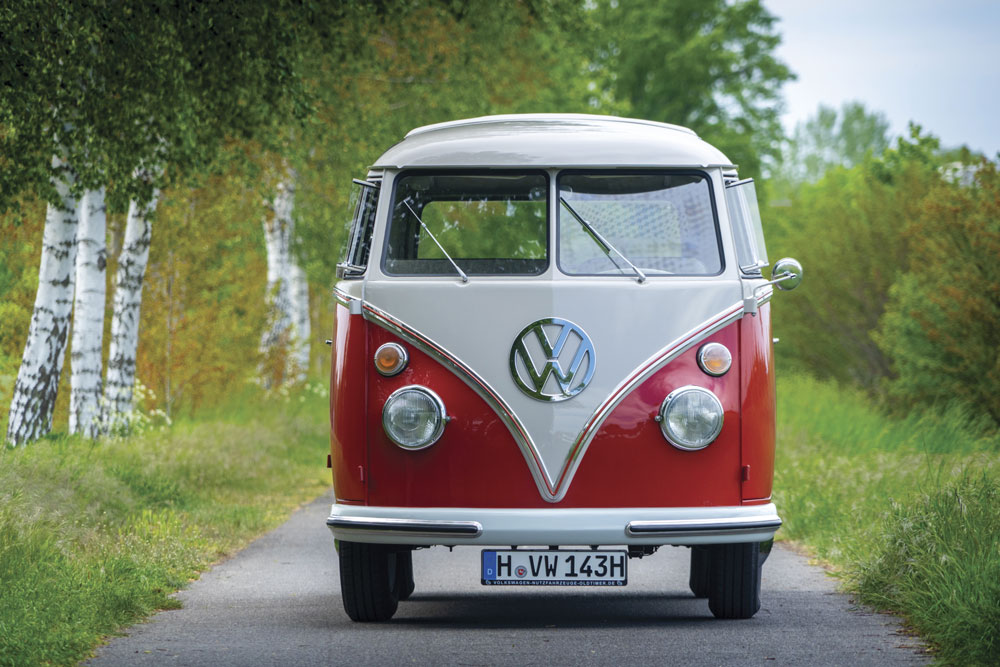
The first generation of Transporter has become affectionately known as the split-screen, after the design of its windscreen, with two flat panes of glass separated by a central pillar. It entered production on 8 March 1950. Early models had just 1,100cc engines but, by 1965, power had risen to a heady 44bhp from a 1.5-litre air-cooled petrol motor, giving a top speed of 65mph.
These vans, thanks to their upright front and the fact that driver and passenger sat over the front wheels, were remarkably compact, at just 4.10m long (as well as being only 1.66m wide). The painted metal dashboard was screwed directly to the front of the van and the steering wheel (unassisted, of course) was at a distinctly bus-like angle. Side doors were a hinged pair, much like the barn doors at the rear of front-engined vans, and onto which converters often mounted cookers.
In 1956, production of the T1 relocated to Hanover – still the home of the Transporter today – and, by 1962, a million vans had been built. By then, of course, campervan derivatives were becoming firmly established in the market, with Westfalia being a pioneer on the Continent with its Campingbox.
This was a set of removable furniture, including seats, cupboards and cooker that could quickly turn the weekday workhorse into a weekend leisure vehicle.
In the UK, the Volkswagen’s success was initially limited by its high price and import tariffs. That’s not to say British converters didn’t use it, though, as the likes of Canterbury-Pitt, Devon and Dormobile were early exponents of the German base vehicle.
In fact, Peter Pitt (of Canterbury-Pitt) drove his VW-based Moto-Caravan through the Royal Park at Windsor (in which commercial vehicles were not allowed) to create legal history. Having won his case, campervans enjoyed the same speed limits as cars, but were subject to the lower purchase tax then applied to caravans!
Early conversions were usually very simple and frequently lacked any elevating roof (stooping only inside) but, today, many split-screens have received modern interiors. Buyers seeking a splitty will now need deep pockets and be prepared to accept the limitations of a vehicle that’s at least 53 years old.
Mark Reynolds of parts and accessories supplier, Just Kampers, says that hasn’t diminished demand and the best examples are still increasing in value. You’ll need between £35k and £50k for a really nice one, with some rare models valued at over £100k. Even a rough, rolling restoration vehicle will be at least £15k, so be sure that you know what you’re looking at, especially the quality of past restoration or modifications.
Example model: 1966 Split-Screen Camper, £32,000
This left-hand drive splitty (pictured below) came to the UK from the USA in 2008. It has a modern conversion that looks just right and retains the factory roof, while having a rebuilt 1.6-litre engine and original duo-tone colour scheme. Looks great value for one of these!
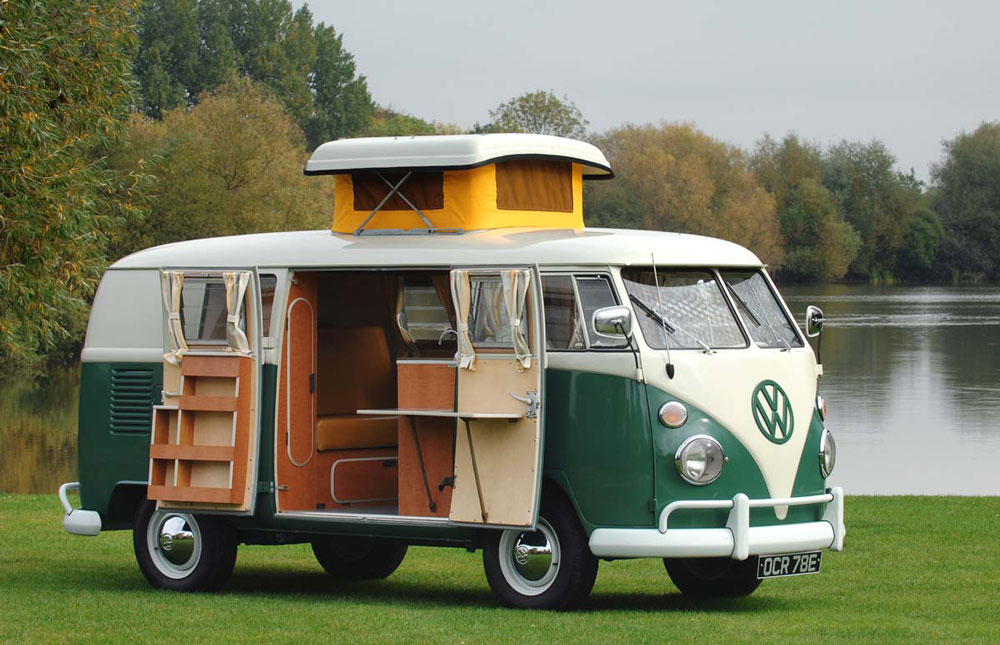
Volkswagen T2 – 1967-1979
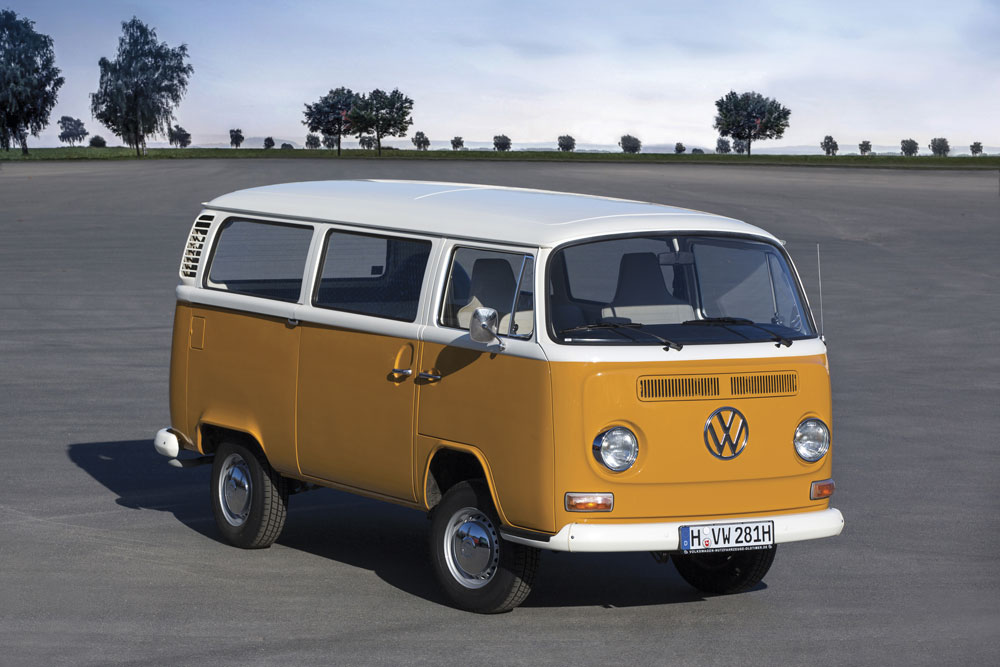
It’s still rear-engined and air-cooled but the T2, or bay window van, which arrived in 1967, introduced a feature that’s so much part of VW camper life today – the sliding side door. It was with this generation, too, that side kitchen layouts (still dominant over 50 years on) really became established.
Power from the 1.6-litre engine was now up to 47bhp and an automatic gearbox (with three speeds) was offered for the first time, but the biggest change was, of course, the restyled front with its curved windscreen – or bay window. The new model was longer, by five-and-a-half inches, as well as fractionally taller and wider.
The Bay also received a midlife facelift in 1972 with the cab door steps moving inside the doors and the bumpers becoming much bigger and squarer. There were also a number of new engine options along the way – firstly, a 1.7-litre 66bhp unit in 1971, then a 1.8-litre with 68bhp and, from 1975, a 2-litre with 70bhp.
In the UK, Danbury, Devon and Dormobile were perhaps the best-known names amongst many others converting the VW, including Motorhomes International with its famous side-hinged Spacemaker roof fitted to the Viking model. The ultimate, though, was the German Westfalia – something that’s still true today, with Mark from Just Kampers reporting that a top-condition, right-hand drive example with original interior could be worth as much as £50,000.
“Prices are definitely going up for the best examples,” Mark confirms, with even a rough but roadworthy example fetching £8k to £12k. The days of students buying them for a few hundred quid are a distant memory…
With even the last of the German-built bay window campers now being over 40 years old, they are firmly in the classic category, with all that entails. Very few examples will survive that haven’t had major restoration work, but there is an alternative for those wanting the period charm with a newer registration plate.
From 1995, the bay window VW was made in Brazil and production there continued right up until December 2013, when it was finally killed off by safety legislation. Before that date, many of these were imported by Danbury, which converted them into campers (and often switched them from left to right-hand drive).
Officially known as the T2c, the Brazilian-built VWs (see the red camper below) are instantly recognised by their taller, squarer roofline. From 2005, a more fundamental change – to water-cooled engines (a 1.4-litre motor from the Polo) – resulted in an afterthought of a grille added on the nose.
If you’re looking at a T2c, just remember that you’re buying into 1970s creature comforts and safety levels, not those of the 2000s…
Example model: 1969 Westfalia, £25,850
Older VW campervans often appear at classic car auctions such as CCA. This lovely, restored, American-market Westfalia was only sold as recently as June 2020 and was the more expensive of two Type 2 campers in that auction. The other one, a right-hand-drive, made £24,200.

Volkswagen T3 – 1979-1990
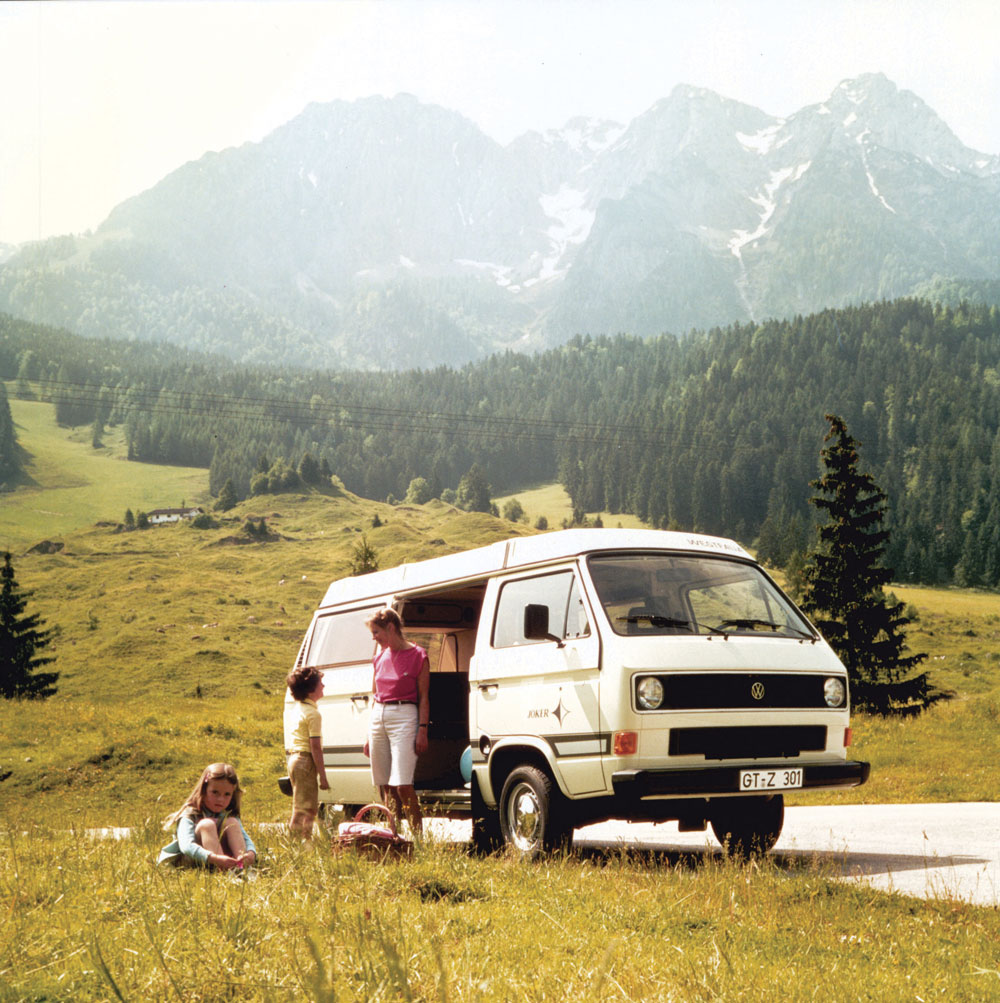
The T3 (or Type 25) was 125mm longer and 65mm wider than its predecessor but a more radical departure was the squarer styling, earning it the less-than-lovely nickname of the ‘brick’ or ‘wedge’.
It carried on with rear-mounted, air-cooled engines (at least to start with), but the motors were mounted lower and gone was the door in the rear to access the engine, replaced by a flap behind the number plate to check the oil. More serious work was done by lifting a lid inside, directly over the power unit – or in the middle of the lounge floor in a Karmann Gipsy coachbuilt!
Two years after the T3’s launch, the first diesel Transporters arrived, but these were underpowered and unreliable. Petrol versions still dominated and these switched to water cooling in 1982, with a 1.9-litre unit offering 60bhp or 78bhp (a 2.1-litre 112bhp fuel-injected option followed in 1984).
Swivel cab seats were now a regular addition to create more living space and the roomier body and lower engine deck allowed converters to come up with new ideas, such as Richard Holdsworth’s Vision, with its rear kitchen, and the Diamond RV Autocruiser with a shower compartment.
Dormobile had folded by this time, but Devon and Danbury were still popular brands in the VW world and the first Auto-Sleeper Volkswagen joined the scene. Later adopting the Trident name, it became a best-seller.
I have fond memories of the T3, as these were among the first campervan I tested for these pages. However, Geneve Brand, editor of our sister mag, Campervan, is a real enthusiast, having owned one for 13 years. She describes them as, “a great entry-level campervan, as they are cheap and plentiful,” adding that secondhand parts are widely available and many components are still obtainable new, at reasonable prices, from Germany.
She warns that rust is the big enemy, though, so budgeting for annual welding repairs might be essential, while seeking out an old-school garage is also necessary if you’re not doing DIY maintenance.
Perhaps that’s part of the appeal, though, as Mark at Just Kampers suggests that these are “the last analogue campers, requiring no specialist tools.”
Prices, though, have been pulled up by the fact that many have been priced out of the T1/T2 market. Geneve paid £4k for hers (with a home conversion) in 2007 and sold it recently for £10k. The very best T3s are worth up to £20k and you’d have to budget as much as £12k to £15k for a nice branded conversion, says Mark.
If you want an investment tip, go for a rare Syncro 4x4 (a proper off-roader with greatly increased ground clearance). These now have a cult following in the States, with some selling for over $100,000!
Example model: 1989 Holdsworth Villa, £9,999
This camper has its original interior and a period bodykit and has been owned by one of the directors at VW camper specialist Hillside Leisure. It had 156k miles on the clock and looks like a great, affordable first camper – especially as it came with a 12-month warranty. It was available, until sold, at hillsideleisure.co.uk/used-campervans

Volkswagen T4 – 1990-2003
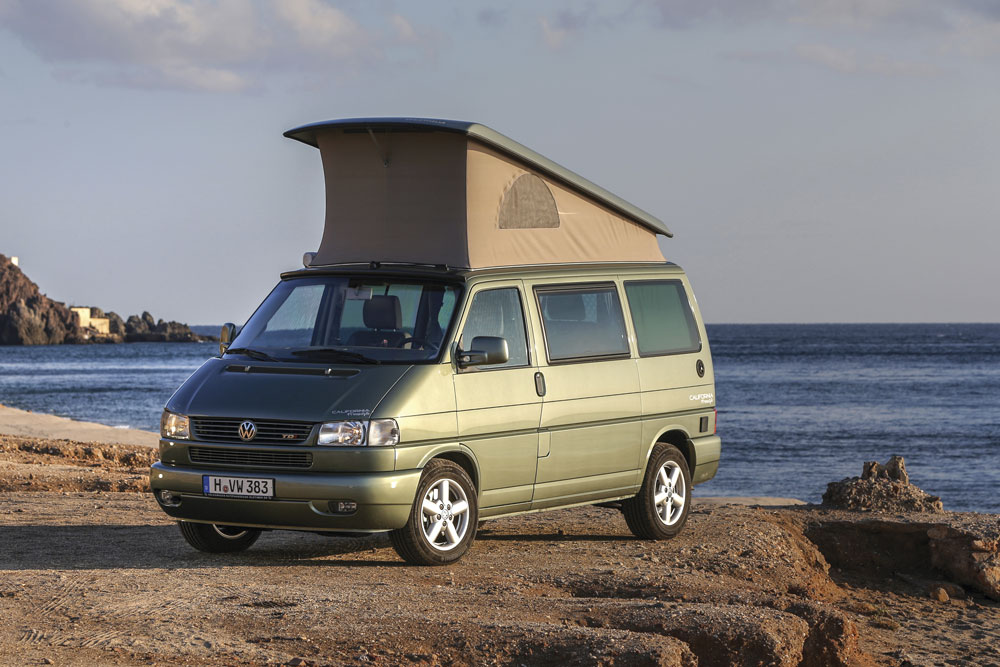
This was a revolution! Gone was the rear engine of the previous 40 years, replaced by a front-mounted motor driving the front wheels. In the UK, Bilbo’s (still converting VWs to this day) stole a march on all of its competitors by converting a left-hand drive example, which was on the front cover of this magazine’s July 1991 issue. Our tester wrote, “it is exceptional and in no other light commercial cab have I ever felt so in tune so completely, so quickly.”
Initially, there were 1.9-litre/60bhp and 2.4-litre/78bhp diesels or a 2-litre petrol (84bhp) engine. Then, following its 1996 facelift, came 2.5-litre turbo-diesels with 88, 102 or, in left-hand drive only, 150bhp.
Quickly, these TDI models became the ones to have, despite their significantly higher prices, although a 110bhp 2.5-litre petrol unit was also offered for those who preferred not to fill up at the derv pump.
Some later T4 campers also benefited from the longer, smoother nose of the Caravelle people-carrier (see photo above) and by the end of T4 production around two million examples had left the line – more than either the T1 or T3.
In the meantime, the Transporter had established itself not just as a campervan but as a basis for larger coachbuilt motorhomes, thanks to its conventional front-engined design.
The choice of short or long-wheelbase derivatives for the first time brought further innovation in terms of camper layouts, too, including Auto-Sleepers’ popular Topaz with its rear washroom with cassette toilet and shower. Coachbuilts came from a number of manufacturers, but a true classic was the compact Auto-Sleeper Clubman featuring a stylish monocoque body (which, sadly, wasn’t to continue onto the T5).
They may lack the retro charm of earlier VWs but the T4 makes a great camper for those on a budget. Rob Williams at campervan dealer, Campersales, in West Sussex, describes them as “super robust,” going on to add that they’re quite simple to maintain as they predate ECUs.
He advises that post-1996 models have better rustproofing and the TDI engines are very good, while air-conditioning was found on some examples, making them feel even more modern and usable. You can pay up to £15k for a really good T4 camper, with (left-hand drive only) Westfalias fetching more as they had a much higher spec than British-built campers.
Example model: 1999 Westfalia California, £16,950
This 169k-mile left-hand drive Westfalia was originally imported to the UK by campersales and has been sold by it several times since. It has loads of history with it and a high spec, including the 2.5 TDI engine and air-con
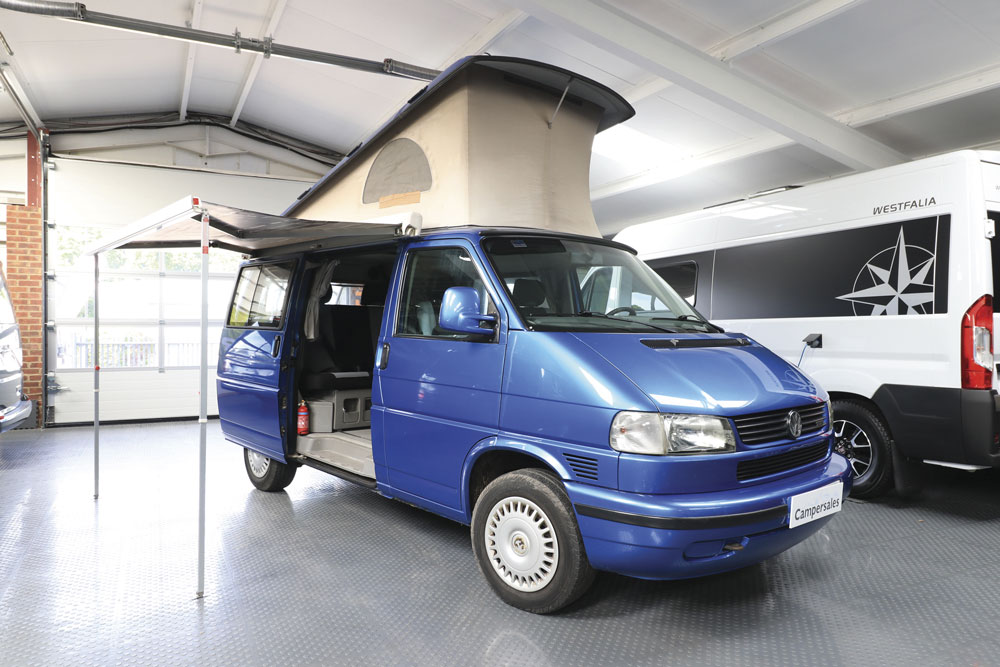
Volkswagen T5 – 2003-2015
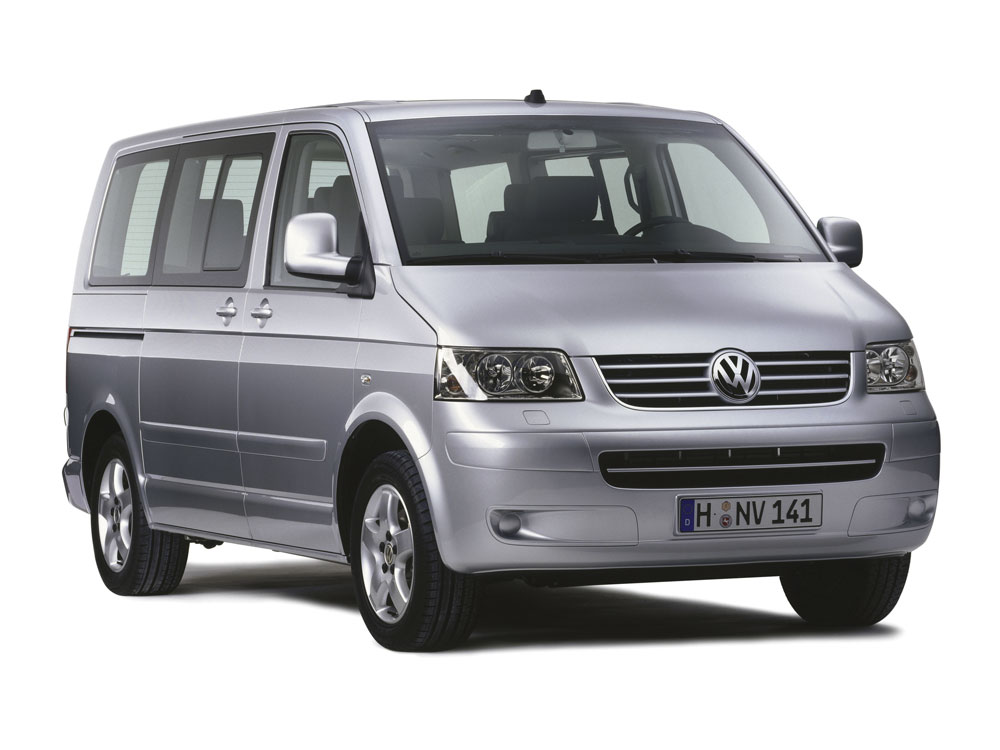
I’ve just sold my T5 and I can honestly say that, if you can’t afford a T6, a post-2009 facelift T5 – often referred to as a T5.5 – really is the next best thing. For around half the price of a new T6.1 you could be driving something that, to all but VW fans, looks and feels pretty close to the current model.
Volkswagen described the T5 as having 'a much more powerful appearance.' Its flatter sides meant more internal space, an adjustable steering wheel introduced greater driver comfort, and the gearstick moved from the floor to the dashboard in line with commercial vehicle trends.
In our special feature on the new van in the November 2003 issue, we wrote: 'Stepping back into a T4 after driving the T5 showed just how much progress VW has made. The old van still seems competent, but driver comfort and handling are now in a different league.'
We were even more impressed when the T5.5 came along, with its new 2-litre TDI engines replacing the previous 1.9-litre four-cylinder and 2.5-litre five-cylinder diesels. The facelifted versions are easily spotted, thanks to the redesigned nose with grille and headlights merging together.
Like the T4, there were petrol models, too, short and long wheelbase versions, and four-wheel drives, now called 4Motion (rather than Syncro) using a Haldex coupling. After 2009 came the introduction of the seven-speed DSG dual-clutch automatic gearbox and the first twin-turbo diesel, offering 178bhp.
Coachbuilts soon arrived on the T5 from VW specialist, Karmann, and others, but were never anything like as commonplace as T4-based motorhomes. Campervans from leading manufacturers such as Auto-Sleepers, Bilbo’s and CMC Reimo were usually adapted from T4 designs, but the big news was the California.
Here was a campervan built entirely in-house by Volkswagen – a unique undertaking in the motor industry. It boasted a very high spec, including an electric elevating roof and car-like features rarely seen on a camper. However, a downside, for some, was a sliding door on the offside on UK right-hand drive models.
Rob Williams at Campersales warns that T5s can be more expensive to fix than T4s as they are more complex and have known issues such as leaky sliding windows (£600 a side to replace). Warped manifolds can affect 2.5TDIs, too, costing £2k to fix – exhaust gases in the cab are the giveaway sign. That said, Rob says that expenditure can easily be justified because there is minimal depreciation to worry about.
Around £25k is probably the starting point for a good T5, with ‘motorhome bodyshell’ conversions worth more than those based on a panel van.
Example model: 2014 Bilbo's Celex, £35,950
Based on a window van and featuring the classic side kitchen layout, this 34k-mile T5.5 has the highly desirable 140PS engoine, diesel heating and one of the best conversions of its day and was available at bilbos.com
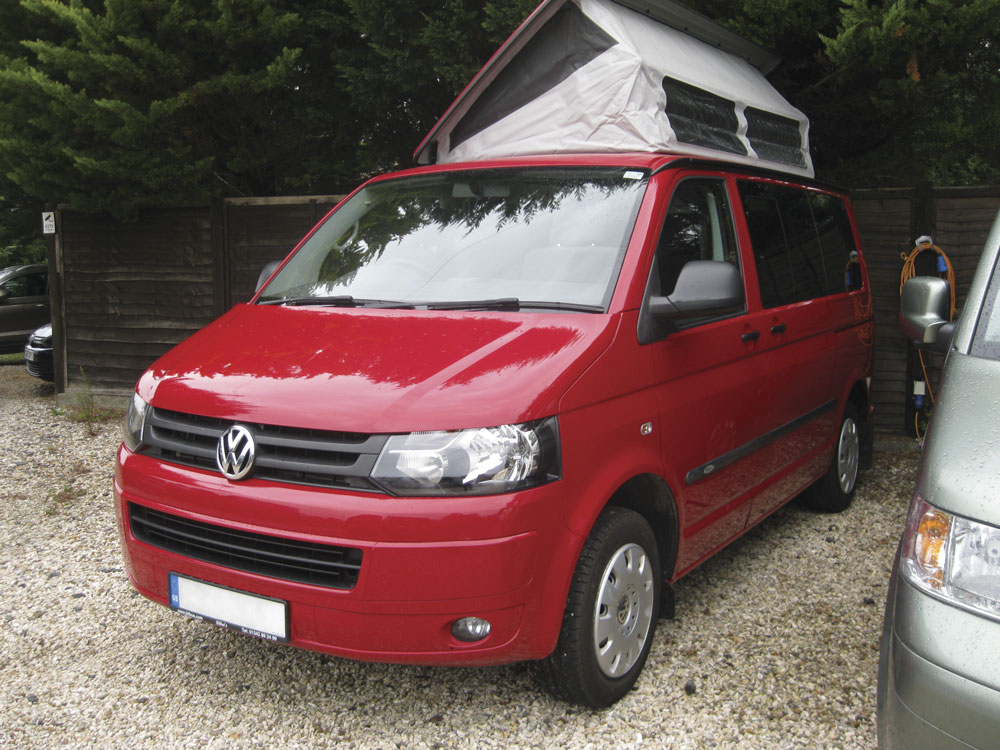
Volkswagen T6 – 2015-present
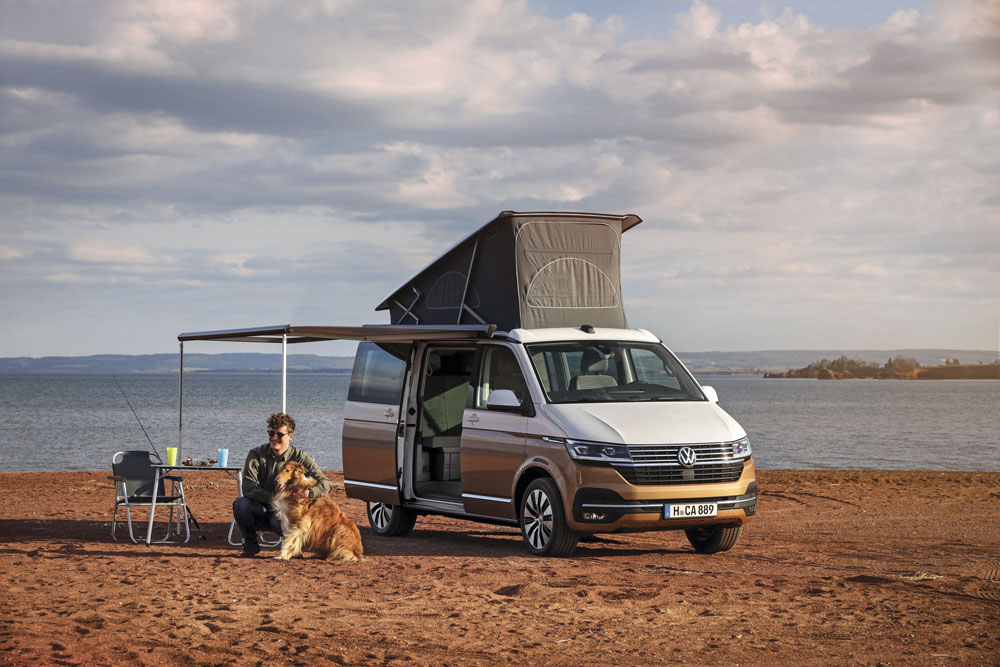
When the T6 Transporter arrived, it’s fair to say that we were a little underwhelmed. Not that it wasn’t good, just that it didn’t look very different from a T5. One well-known converter even added a guide to ‘spot the difference’ between the two on its website...
The big difference, of course, is that the T6 is kinder to the environment, thanks to Euro 6 engines that use AdBlue, but the newer vehicle is also smoother and more refined. Petrol models (called TSI) were reintroduced later, but only stayed on the market in the UK for a short time – if you want one (and they are very refined to drive), you’ll need to be patient in your search!
Bonnet, bumper, grille and headlights were all changed as T5 morphed into T6, but it was the subtlest of updates, accompanied by enhanced safety features. Cynics said it was Volkswagen’s reaction to the growing popularity of the rival Ford Transit Custom.
Whatever the reason for the change, it was just four years later – in autumn 2019 – that another evolution of the still-iconic camper arrived. Strangely, despite a more noticeably new look than when T5 became T6, the latest Transporter is not the T7, but the T6.1. No, we don’t know either…
What we do know is that this is the most sophisticated model yet. Electric power steering has allowed the introduction of new safety kit such as Cross Wind Assist and Lane Assist. Inside, the cab gets a new look that’s much closer to the design of the larger Crafter, while a sophisticated digital dashboard display is fitted to the latest California Ocean camper. On the outside, the new model is distinctive with its much deeper grille.
Its popularity is as strong as ever. Volkswagen now builds over 18,000 Californias per annum and, in the UK, the number of VW campervan conversion specialists seems to have grown exponentially, although that makes it even more important to be sure that you buy the right-spec camper from a reputable converter that builds to the highest safety standards.
Rob at Campersales sums up the VW’s success, saying, “There’s nothing quite like them,” and pointing out that the VW service network is familiar with working on campervans in a way that other commercial van dealers aren’t. Few vehicles of any size, type or price keep their value like a good VW camper. And even fewer will give you so much fun along the way…
Example model: 2018 Hillside Birchover S, £36,995
Can't stretch to a new T6.1? How about this very low mileage example of Hillside's entry-level T6 Birchover S, with the 84PS engine, roof bed and crash-tested RIB bench seat, as well as a host of options. It was previously available from Hillside.
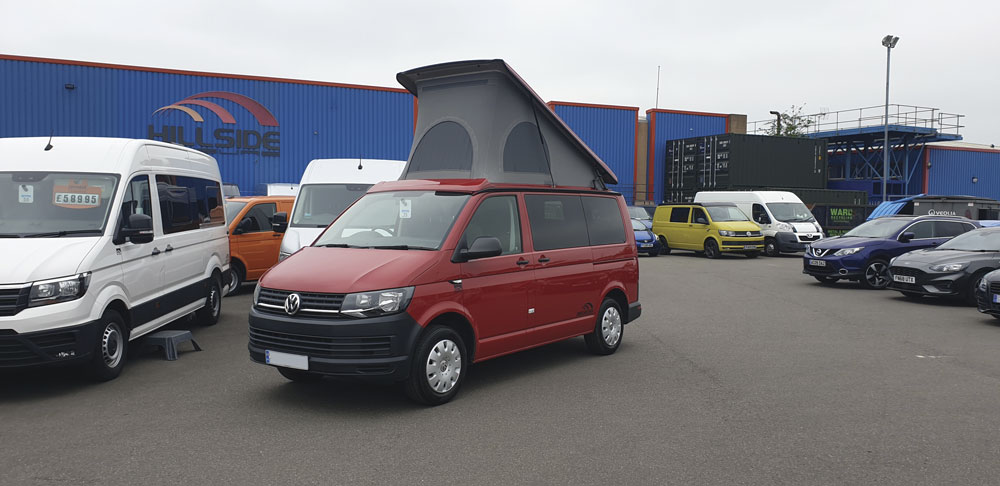








Recent Updates
Engine management lights: all you need to know
What is the engine management light? What does it mean, and what do I have to do? ...
Motorhome air suspension: all you need to know
Motorhomes are heavy and the additional weight of equipment and height of the bodywork can increase the loads ...
Motorhome WiFi: how to get better motorhome internet
Staying connected on the move is more and more essential, so relying on campsite WiFi isn't an option – here ...
A class of their own - our guide to A-class motorhomes
Thinking of trading up to an A-class, or even going straight to the top of the motorhome tree? We guide you ...
Explore overseas on a motorhome dream tour
Enjoy exotic travel in a campervan or motorhome by hiring, swapping with someone else or exporting your ...
Motorhome water systems: everything you need to know
On-board water is an important part of every motorhome – here’s everything you need to know ...
Campervanning in Europe: what you need to know
Whether you're planning a leisurely drive through the French countryside, navigating bustling city streets in ...
Campervan security: all you need to know
With thefts on the increase, it’s important to know how to keep your campervan secure and prevent campervan ...
Campervan furniture: everything you need to know
Our campervan experts guide you through all the essentials for your campervan, including tables, chairs, ...
Campervan finance: how to fund your purchase
Here we look at the different types of campervan finance available, to help you decide what’s the best option ...
Other Articles
Britain’s best used motorhomes
Want a great motorhome without paying the premium for a new one? Here's a guide to the best you can get in the pre-owned market for each layout, ...
Which motorhome? Choosing the perfect motorhome for you
Choosing a motorhome or campervan is one of the biggest buying decisions you’ll ever make, so it's important ...
Campervan washroom essentials: stay fresh on the road
Our guide will take you through the campervan washroom essentials you'll need so you're well-prepared for ...
Dogs in campervans: all you need to know
Follow our advice and your dog will enjoy campervanning as much as you do ...
Electric campervans: all you need to know
Our guide will take you through everything you need to know about electric campervans and what the future ...
Motorhome electrics: a complete guide to your motorhome electrical set-up
Motorhome electrics can dramatically enhance the convenience and comfort of your vehicle – but they can be ...
Lighting for campervans: all you need to know
We guide you through all the lighting options available for you and your campervan, including interior ...
Electric bikes for motorhomes: our ultimate guide
Read our comprehensive guide to electric bikes for motorhome owners, helping you add electric power to your ...
Our guide to 'cheap' motorhomes in 2024
If you're on the hunt for an affordable new motorhome, this is the best place to start – we've rounded up a ...
Campervans in winter: all you need to know
Here's your guide to preparing your campervan for the colder months, whether you will be using it or putting ...